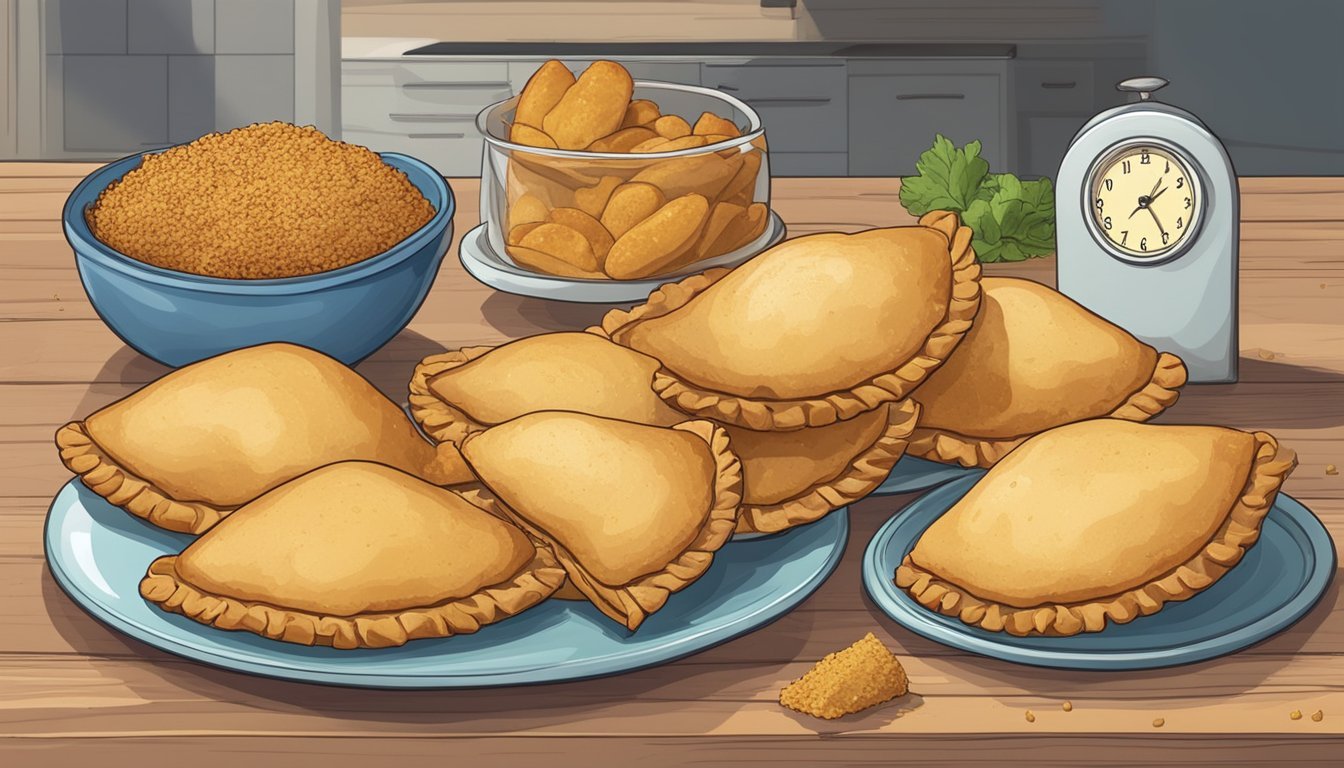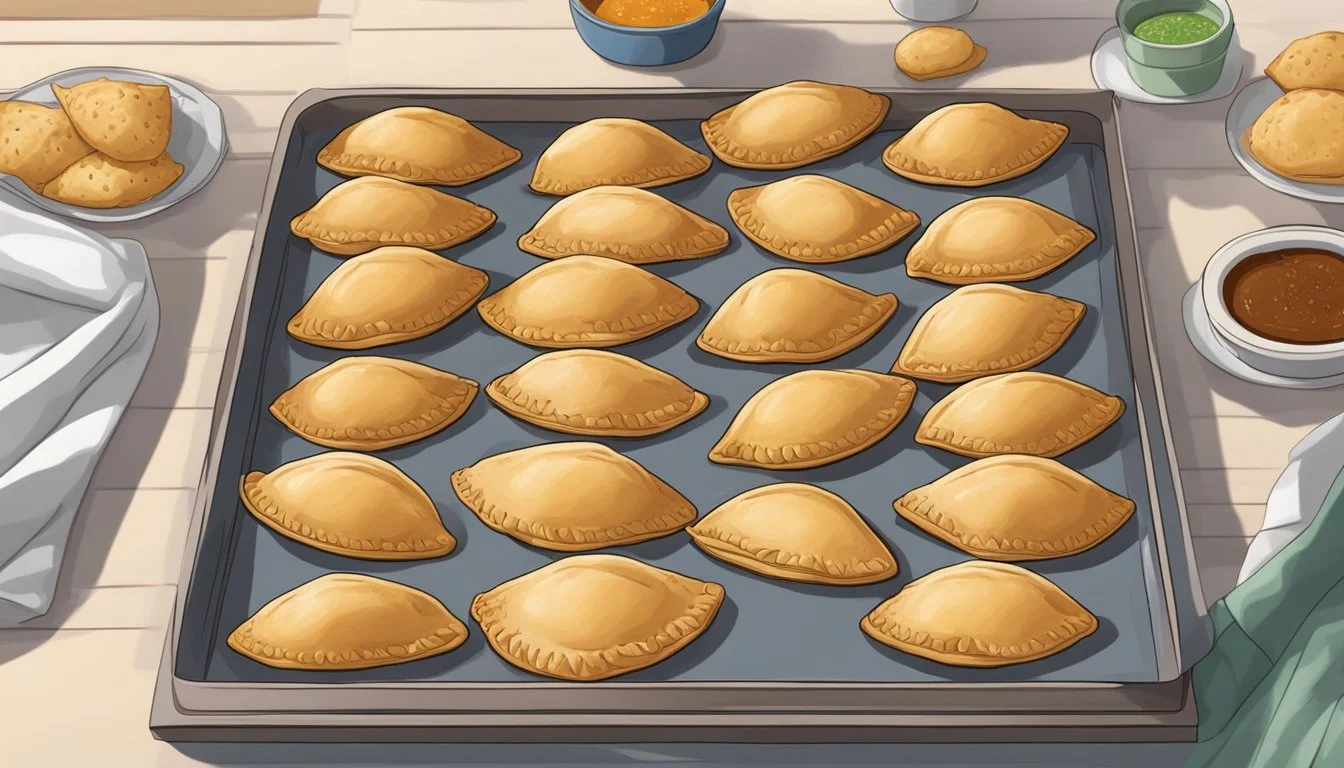How Long Do Empanadas Last?
Storage Tips and Shelf Life
Empanadas, the versatile pastries enjoyed throughout Latin America and Spain, have become a beloved snack worldwide. When stored properly in an airtight container, empanadas can last 3-5 days in the refrigerator or up to 3 months in the freezer. This makes them a practical option for meal prep and quick, tasty snacks.
Refrigeration inhibits bacteria growth and keeps empanadas fresh for up to four days, but freezing extends their shelf life significantly. It's essential to handle storage correctly, from using airtight containers to ensuring minimal stacking, in order to maintain their quality.
Despite these guidelines, the taste and texture of empanadas may deteriorate over time. Consuming older empanadas first and keeping newer ones at the back helps retain their deliciousness. With these tips, you can enjoy your favorite empanadas without worrying about spoilage.
Understanding Empanadas
Empanadas are a versatile pastry enjoyed in many cultures.
Dough: The dough is typically made from flour, water, and fat such as lard or butter. This provides a flaky texture. For a twist, some people may add a bit of sugar to sweeten the dough slightly.
Fillings: Fillings vary widely. Common savory options include beef, chicken, and vegetables. Beef and chicken are often seasoned with spices and mixed with ingredients like onions, olives, or boiled eggs.
Meat: Beef and chicken are popular choices. Beef empanadas often use ground or finely chopped beef, while chicken empanadas may include shredded or diced chicken.
Cheese: Cheese can be found in many empanadas, adding creaminess and flavor. Common types include mozzarella, cheddar, or even a tangy queso fresco.
Vegetables: Vegetables such as bell peppers, onions, and potatoes are frequently used. These add texture and nutritional value to the fillings.
Fruit: Sweet empanadas often contain fruits like apples, peaches, or berries. These can be spiced with cinnamon or sugar for dessert varieties.
Savory vs. Sweet: Empanadas can be either savory or sweet. Savory variants typically include proteins and vegetables, while sweet ones feature fruits or sweetened fillings.
Shapes and Sizes: Empanadas can be made in various sizes, from small, bite-sized snacks to larger, meal-sized portions. They are usually crescent-shaped, but the exact shape can vary.
Cooking Methods: Empanadas can be baked or fried. Baking results in a lighter, less greasy pastry, while frying gives a crispier texture. Both methods have their unique appeal.
This diversity makes empanadas a beloved culinary delight worldwide.
Preparing and Baking Empanadas
Proper preparation and baking are crucial for achieving the perfect empanada. This entails preparing the dough, meticulously filling and sealing, and baking with precise timing and temperature.
Dough Preparation
The foundation of a great empanada starts with well-prepared dough. Begin by mixing flour, salt, and a bit of sugar. Incorporate cold butter or margarine until the mixture resembles coarse crumbs. Gradually add cold water to bring the dough together.
Once combined, knead the dough lightly, then wrap it in plastic wrap. Chill for at least 1 hour to relax the gluten and make it easier to work with. This resting period also contributes to a flakier texture when baked.
Filling and Sealing Techniques
Fillings for empanadas can vary widely, from meats to vegetables to sweet options. Commonly, combinations of beef, chicken, cheese, and vegetables are used.
Spoon the filling onto one side of each rolled-out dough circle. To seal, gently fold the dough over the filling, creating a half-moon shape. Press the edges together firmly, then crimp with a fork or twist by hand to create a tight seal. This step is crucial to prevent the filling from leaking during baking.
Baking Basics
Preheat the oven to 375°F (190°C) before baking. Place the empanadas on a baking sheet lined with parchment paper. To achieve a golden brown and crispy crust, brush the empanadas with egg wash (a mixture of beaten egg and water).
Bake for 20-25 minutes or until the empanadas are golden brown. Adjusting the baking time might be necessary based on the size and thickness. Ensure the internal temperature reaches at least 165°F for properly cooked fillings. By adhering closely to these steps, your empanadas will bake to perfection with ideal texture and flavor.
Storing Uncooked Empanadas
Proper storage techniques can significantly extend the freshness and quality of uncooked empanadas. Essential tips include refrigeration and freezing methods to preserve their taste and texture.
Refrigeration Tips
When storing uncooked empanadas in the refrigerator, use an airtight container. This prevents moisture loss and keeps flavors intact. Avoid stacking empanadas on top of each other to prevent them from becoming soggy or misshapen.
Place the container on a refrigerator shelf, not the door, to maintain a consistent temperature. It's best to consume refrigerated uncooked empanadas within 2-3 days to enjoy optimal taste and quality. Plastic wrap or foil can be used to create a tighter seal around the container for extra freshness.
Freezing Methods
To store uncooked empanadas for a longer period, freezing is the best option. Place the empanadas in a single layer on a baking sheet and freeze until solid. Once frozen, transfer them to freezer bags or an airtight container. This method prevents the empanadas from sticking together.
When using freezer bags, remove as much air as possible before sealing. Properly stored, uncooked empanadas can last up to 3 months in the freezer. Thaw the empanadas by moving them to the refrigerator overnight before cooking. This gradual thawing helps maintain their texture and flavor.
Keeping Baked Empanadas Fresh
Properly storing baked empanadas is essential for maintaining their taste and texture. The key points include cooling them properly and employing effective refrigeration strategies.
Cooling Before Storage
Before storing baked empanadas, they must be allowed to cool to room temperature. Placing hot empanadas directly into storage containers can trap steam and lead to sogginess.
Allow empanadas to cool on a wire rack to ensure even cooling and to prevent condensation formation. Make sure they are in a single layer to avoid squashing them. This step is crucial because improperly cooled empanadas can spoil faster and lose their crispiness.
Refrigeration Strategies
To extend the shelf life of baked empanadas, it is important to store them correctly in the refrigerator. Use airtight containers to keep them fresh and to prevent moisture from making them soggy. Plastic wrap or foil can also be used to tightly cover the empanadas before placing them in the container.
Avoid stacking the empanadas directly on top of each other. Instead, create layers separated by parchment paper if stacking is necessary. Properly refrigerated, baked empanadas can last for 3-5 days. Always make sure the refrigerator temperature is set to below 40°F (4°C) to ensure food safety and quality.
Proper Reheating Techniques
To enjoy the best flavor and texture of empanadas, it's essential to reheat them correctly. Whether using an oven, microwave, or stovetop, following specific methods ensures satisfying results.
Oven Reheating Method
For the best texture, prefer oven reheating. Start by preheating your oven to 350°F (175°C). Arrange the empanadas on a baking sheet, ensuring they don't touch to allow even heating.
Cover them lightly with aluminum foil for the first half of the heating period to retain moisture. Bake the empanadas for 15-20 minutes, removing the foil halfway through the process to let them crisp up.
After baking, allow them to cool slightly before serving to avoid burning your fingers and to let the filling set.
Microwave Tips
Microwave reheating is quick but can affect the texture. Place empanadas on a microwave-safe plate, spacing them apart. Cover lightly with a damp paper towel to keep them from drying out.
Set the microwave to medium power and heat in 30-second intervals, checking the warmth after each interval to avoid overheating. Typically, about 1-2 minutes suffice, but can vary depending on the empanada's size and the microwave's wattage.
This method ensures rapid reheating but be cautious, as it might result in a softer shell.
Stovetop Frying Approach
For a crispy finish, stovetop frying is effective. Heat a skillet over medium heat and add a small amount of oil. Once the oil is hot, place the empanadas in the skillet.
Fry them for about 2-3 minutes on each side or until they turn golden and crispy. Be careful not to overcrowd the skillet to ensure even frying. After frying, let them cool on a paper towel to absorb excess oil.
This method revives the original fried texture and enhances the empanadas' flavor.
Best Practices for Empanada Longevity
For empanadas to stay fresh and flavorful, proper storage techniques are crucial. Factors such as controlling moisture, avoiding freezer burn, and ensuring optimal storage conditions play a vital role in preserving their quality.
Moisture Control Techniques
To maintain the texture of empanadas, managing moisture is key. Excess moisture can lead to sogginess, detracting from their desired crispiness. Placing empanadas on a tray lined with parchment paper helps to absorb any excess oil. When storing in the refrigerator, use an airtight container or wrap each empanada individually in plastic wrap to prevent condensation buildup. Avoid stacking them directly; instead, insert parchment paper or aluminum foil between layers if necessary.
Averting Freezer Burn
Properly freezing empanadas can extend their shelf life significantly. To prevent freezer burn, ensure that empanadas are completely cool before freezing. Wrap them tightly in aluminum foil or heavy-duty freezer bags. An airtight container can also be used for added protection. Label the containers with the storage date. When reheating, thaw them in the refrigerator overnight to reduce moisture loss and maintain flavor.
Optimal Storage Conditions
The right storage conditions are essential for empanada longevity. In the refrigerator, empanadas can last 3-5 days if stored correctly. Maintain a temperature below 40°F (4°C). For long-term storage, freeze empanadas, which can keep for up to 3 months when stored properly. Use a freezer-safe, airtight container or individually wrap each empanada in plastic wrap and then foil to lock in freshness. Reheat in an oven preheated to 350°F (175°C) for 10-15 minutes to ensure they are heated through without becoming soggy.








